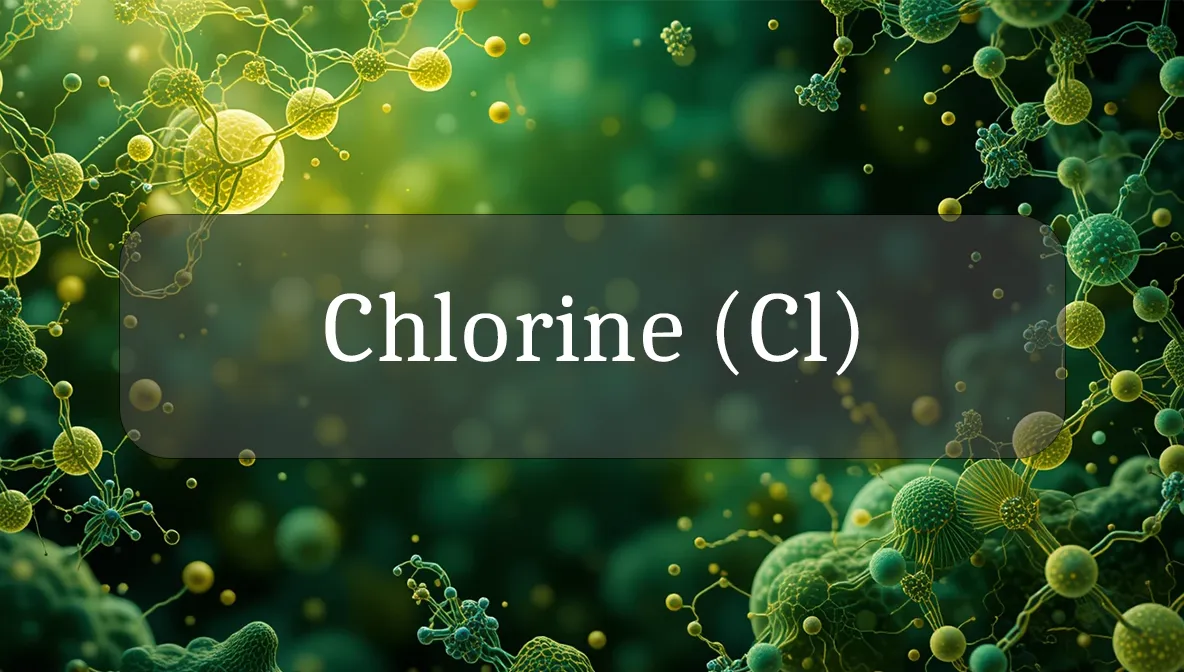Unsung Hero for Your Body’s Balance and Health
Chlorine might bring to mind pool water, but this essential element plays a vital role in keeping your body healthy. As a key part of chloride, it helps balance fluids, supports digestion, and keeps your cells humming. Found in everyday foods like salt and veggies, chlorine is a nutrient you’re likely getting without even thinking about it. Let’s dive into why chlorine matters and how to ensure it supports your wellness goals.
Chemical Identity and Role
Chlorine (Cl) is a reactive, yellowish-green gas, number 17 on the periodic table. In your body, it exists mostly as chloride (Cl⁻), a negatively charged ion. Chloride is one of the body’s major electrolytes, working alongside sodium and potassium to maintain fluid balance and electrical activity in cells. It’s critical for keeping your systems in harmony.
Biological Role and Health Impact
Chlorine, as chloride, is a quiet but powerful player in your health:
- Fluid Balance: Chloride helps regulate water in and out of cells, keeping your blood volume and pressure stable.
- Digestion: It’s a key component of stomach acid (hydrochloric acid, HCl), which breaks down food, kills harmful bacteria, and aids nutrient absorption.
- Nerve and Muscle Function: As an electrolyte, chloride supports nerve signals and muscle contractions, including your heartbeat.
- Acid-Base Balance: It helps maintain your body’s pH, ensuring your blood stays slightly alkaline for optimal function.
- Immune Support: Chloride in stomach acid acts as a first line of defense against ingested pathogens.
Adequate chloride keeps you hydrated, energized, and digesting food efficiently, supporting overall vitality.
Sources (Dietary or Environmental)
Chlorine, as chloride, is widely available in foods and water:
- Dietary Sources:
- Table Salt: Sodium chloride (NaCl) is the main source (1 tsp salt, ~2,300 mg chloride).
- Seafood: Fish like cod (3 oz, ~500 mg chloride) or shrimp (3 oz, ~400 mg).
- Vegetables: Celery (1 stalk, ~50 mg), lettuce (1 cup, ~20 mg), and tomatoes (1 medium, ~30 mg).
- Processed Foods: Canned soups, deli meats, and snacks often contain added salt, boosting chloride (limit these for heart health).
- Environmental Sources:
- Drinking Water: Small amounts of chloride occur naturally or are added during water treatment (e.g., as chlorine for disinfection).
- Soil: Plants absorb chloride, which ends up in your diet via veggies or grains.
- Supplemental Sources:
- Rarely needed but found in electrolyte drinks or medical saline solutions for dehydration.
A typical diet provides plenty of chloride, often through salt-rich foods.
Deficiency/Excess Signs
Chlorine imbalances are rare but can occur due to diet or health issues:
- Deficiency Signs (Hypochloremia):
- Fatigue, weakness, or muscle cramps (from electrolyte imbalance).
- Nausea, vomiting, or loss of appetite.
- Confusion or breathing difficulties in severe cases.
- Causes include excessive vomiting, diarrhea, sweating, or certain medications (e.g., diuretics).
- Excess Signs (Hyperchloremia):
- High blood pressure or swelling (edema) from too much sodium chloride.
- Thirst, headache, or confusion.
- Acid-base imbalance (metabolic acidosis), causing rapid breathing or fatigue.
- Excess is rare but can occur in kidney disease, dehydration, or overconsumption of salty foods.
Blood tests can check chloride levels if you’re at risk (e.g., chronic illness or extreme fluid loss).
Supporting Optimal Levels
You can keep chloride levels balanced with these practical tips:
- Eat a Balanced Diet: Include moderate amounts of salt (1–1.5 tsp daily, ~3,500 mg chloride) through whole foods like fish, veggies, or homemade meals.
- Stay Hydrated: Drink 8–10 cups of water daily to support electrolyte balance, especially after sweating or illness.
- Limit Processed Foods: Cut back on salty snacks, canned goods, or fast food to avoid excess chloride and sodium, which can strain your heart and kidneys.
- Replenish After Fluid Loss: After heavy exercise, vomiting, or diarrhea, sip electrolyte drinks (e.g., sports drinks or coconut water) or eat salty foods like broth to restore chloride.
- Support Kidney Health: Healthy kidneys regulate chloride. Reduce sodium and stay active to ease their workload.
- Monitor Medications: Diuretics or laxatives can deplete chloride—ask your doctor about risks.
- Get Checked: If you have kidney issues, frequent vomiting, or unusual symptoms, request an electrolyte panel.
Adults need about 2,300 mg of chloride daily, with an upper limit of 3,600 mg to avoid risks.
Safety, Interactions, and Precautions
Chlorine (as chloride) is safe in normal amounts but requires caution in some cases:
- Interactions:
- Medications: Diuretics, corticosteroids, or laxatives can alter chloride levels. Space doses and follow medical advice.
- Sodium: Chloride in salt is tied to sodium, so high intake can raise blood pressure. Balance with potassium-rich foods (e.g., bananas, spinach).
- Other Electrolytes: Chloride works with potassium and sodium—imbalances in one can affect the others.
- Precautions:
- People with kidney disease, heart issues, or high blood pressure should limit salt to avoid chloride overload.
- Avoid excessive electrolyte drinks or supplements unless needed (e.g., for athletes or illness), as they can disrupt balance.
- Environmental chlorine (e.g., in pool water or cleaning products) isn’t a dietary source but can irritate skin or lungs—use in well-ventilated areas.
- Who’s at Risk? Those with kidney issues, dehydration, or extreme fluid loss (e.g., from illness or endurance sports) need to monitor chloride levels.
Fun Fact
Chlorine was once a wartime weapon! In World War I, chlorine gas was used due to its reactivity, but today, its chloride form safely powers your digestion and hydration, showing how context transforms this element from foe to friend.
Citations
- National Institutes of Health. (2025). Chloride: Fact Sheet for Health Professionals. Office of Dietary Supplements.
- Mayo Clinic. (2024). Electrolytes: Understanding Chloride’s Role in Health.
- Cleveland Clinic. (2023). Chloride and Fluid Balance: What You Need to Know.
- USDA FoodData Central. (2025). Nutrient Database for Chloride Content in Foods.
- World Health Organization. (2022). Sodium and Chloride Intake for Health.

